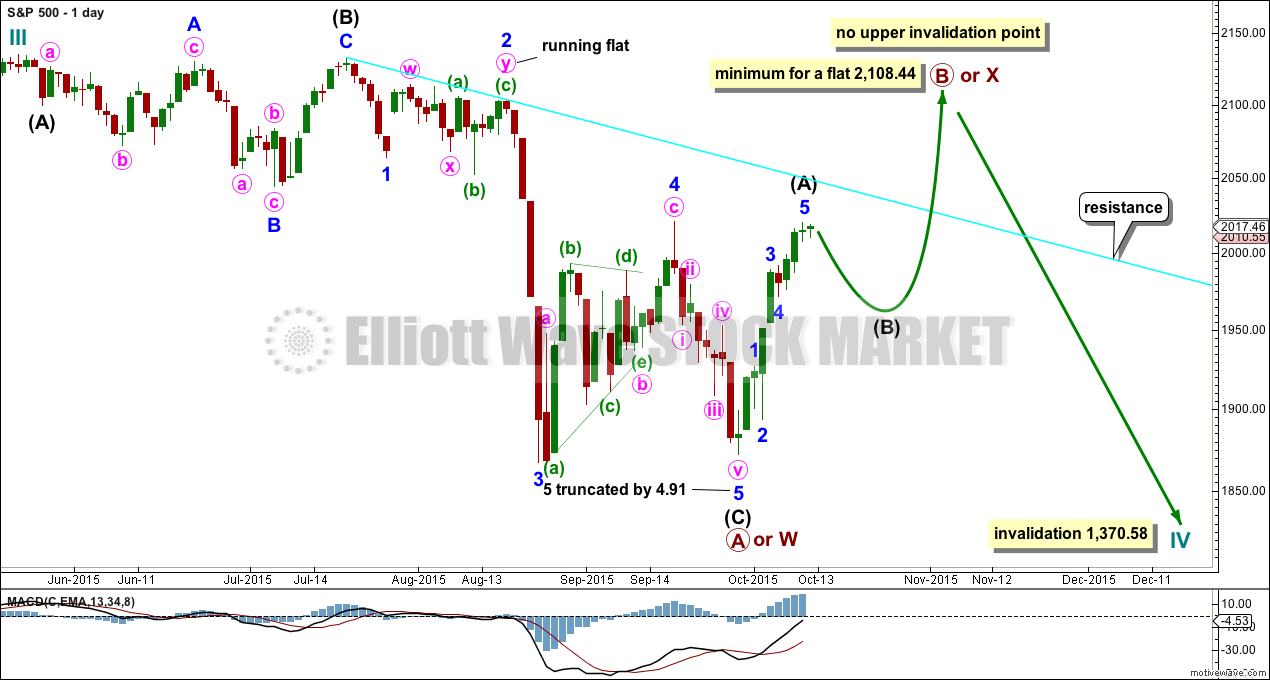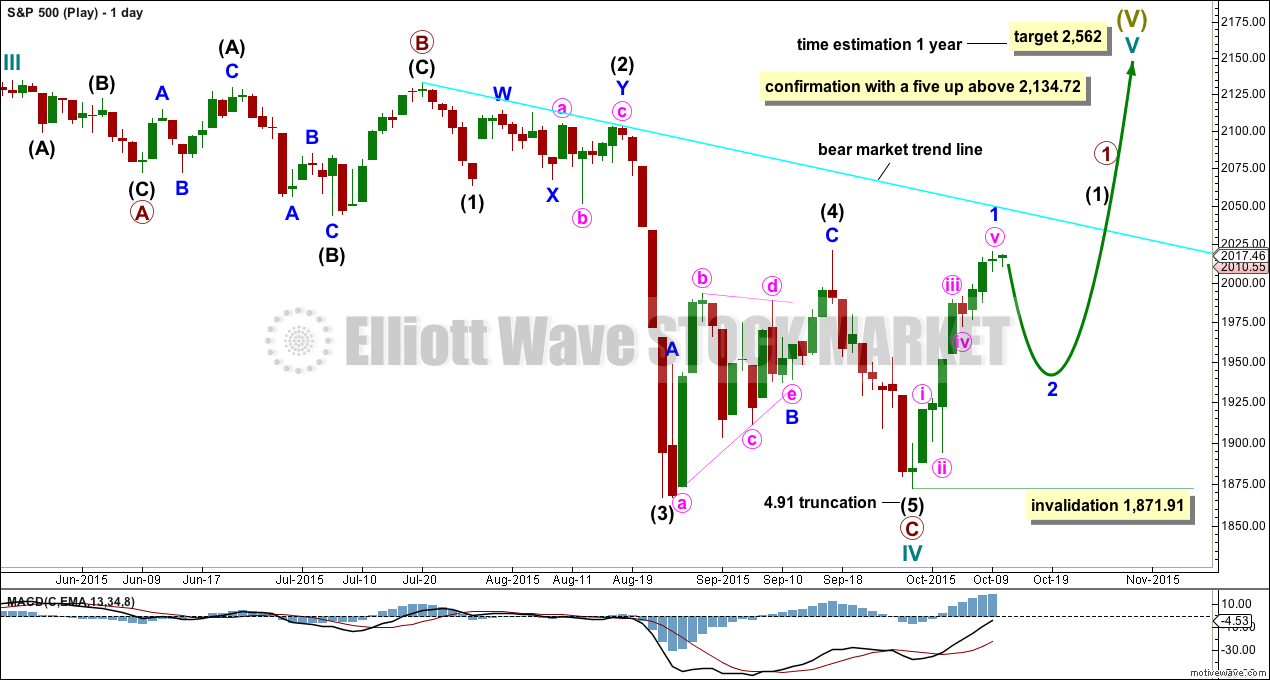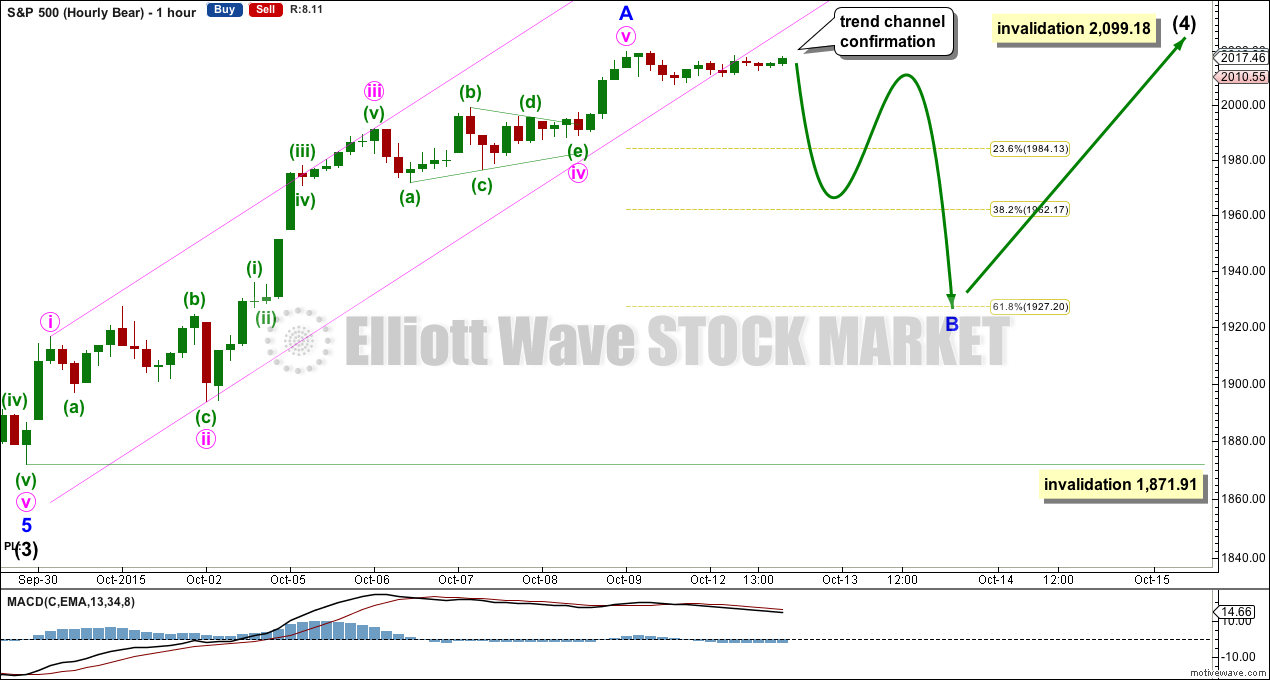A breach of the channel on the hourly chart may be taken as confirmation a correction has begun.
Analysis this week will focus on identifying when the correction may be over.
Summary: All three wave counts expect a sideways / downwards correction to develop from here and to last a few days. This is supported by regular technical analysis. Tuesday should produce a red candlestick or doji.
To see how each of the bull and bear wave counts fit within a larger time frame see the Grand Supercycle Analysis.
To see last analysis of weekly and monthly charts go here.
If I was asked to pick a winner (which I am reluctant to do) I would say the bear wave count has a higher probability. It is better supported by regular technical analysis at the monthly chart level, it fits the Grand Supercycle analysis better, and it has overall the “right look”.
New updates to this analysis are in bold.
BULL ELLIOTT WAVE COUNT
DAILY CHART
Cycle wave IV should exhibit alternation to cycle wave II. Cycle wave IV may find support at the teal channel on the weekly and monthly charts.
Cycle wave II was a shallow 0.41 zigzag lasting three months. Cycle wave IV should exhibit alternation in structure and maybe also alternation in depth. Cycle wave IV may end when price comes to touch the lower edge of the teal channel which is drawn about super cycle wave V using Elliott’s technique.
Cycle wave IV is likely to end within the price range of the fourth wave of one lesser degree. Because of the good Fibonacci ratio for primary wave 3 and the perfect subdivisions within it, I am confident that primary wave 4 has its range from 1,730 to 1,647.
If a zigzag is complete at the last major low as labelled, then cycle wave IV may be unfolding as a flat, combination or triangle.
If cycle wave IV is a flat correction, then within it primary wave B must subdivide as a corrective structure (a three or a triangle) and must end at least 90% the length of primary wave A at 2,108.44. Primary wave B of an expanded flat may make a new all time high above 2,134.72. There is no upper invalidation point for this idea.
If cycle wave IV is a combination, then it would be labelled primary waves W-X-Y. Primary wave X may be any corrective structure and it has no minimum requirement, unlike the B wave within a flat. X waves within combinations are most often deep corrections to achieve the purpose of a sideways movement. X waves may move beyond the start of W waves. There is no upper invalidation point for this idea either.
If cycle wave IV is a triangle, then primary wave B upwards has no minimum requirement, must subdivide as a three wave structure (most likely a zigzag), and may also make a new all time high as in a running triangle. There is no upper invalidation point for this idea either.
Of all Elliott waves it is B waves which exhibit the greatest variety in structure and form. They are extremely difficult to analyse. Often, it is only when they are complete that their structure can be determined.
At this stage, primary wave B looks like it may be unfolding as a zigzag. This may change though.
HOURLY CHART
The channel about intermediate wave (A) is now clearly breached. This may be taken as an indication that the upwards wave of intermediate wave (A) is very likely to now be over and intermediate wave (B) is very likely to have begun. Intermediate wave (A) lasted a Fibonacci eight days. Intermediate wave (B) may be expected to last a Fibonacci five days (a likely minimum if it unfolds as a quick sharp zigzag) or maybe even up to a Fibonacci thirteen days.
Intermediate wave (B) may unfold as one of 23 possible structures (if all the different types of triangles and combinations are counted). It is impossible to say which one will unfold or even which type will unfold at the start, and it may not be clear until the end. It may be a swift sharp zigzag reaching down to the 0.618 Fibonacci ratio of intermediate wave (A) at 1,926. It may be a sideways triangle, flat or combination with deep swings taking up time and ending about the 0.382 Fibonacci ratio at 1,960.
Of all Elliott waves, it is B waves which exhibit the greatest variety in form and structure. B waves within B waves are often very complicated and difficult. This one to come for this wave count is expected to be a B wave within a B wave.
While intermediate wave (B) unfolds the analysis within it will change. The focus will be on identifying when it is over.
Intermediate wave (B) may not move beyond its start below 1,871.91, because intermediate wave (A) is a five.
ALTERNATE BULL ELLIOTT WAVE COUNT
DAILY CHART
It is possible to see cycle wave IV a completed flat correction. This would provide some structural alternation with the zigzag of cycle wave II.
This is a regular flat but does not have a normal regular flat look. Primary wave C is too long in relation to primary wave A. Primary wave C would be 3.84 short of 4.236 the length of primary wave A. While it is possible to also see cycle wave IV as a complete zigzag (the subdivisions for that idea would be labelled the same as the bear wave count below, daily chart) that would not provide structural alternation with the zigzag of cycle wave II, and so I am not considering it.
This idea requires not only a new high but that the new high must come with a clear five upwards, not a three.
At 2,562 cycle wave V would reach equality in length with cycle wave I. Cycle wave I was just over one year in duration so cycle wave V should be expected to also reach equality in duration.
I am adding a bright aqua blue trend line to daily charts. Any bullish wave count such as this one must have three things for confirmation:
1. A clear breach of the bear market trend line (this line is less conservative than a bear market line drawn using Magee’s approach. That line would be almost horizontal. Hence two other conditions are required).
2. Price break above the 200 day Simple Moving Average.
3. A clear five up on the daily chart.
While none of these conditions are met, we should assume the trend remains the same: downwards.
BEAR ELLIOTT WAVE COUNT
DAILY CHART
This bear wave count has a better fit at Grand Super Cycle degree and is better supported by regular technical analysis at the monthly chart level. But it is a huge call to make, so I present it second, after a more bullish wave count, and until all other options have been eliminated.
There are two ideas presented in this chart: a huge flat correction or a double flat / double combination. The huge flat is more likely. They more commonly have deep B waves than combinations have deep X waves (in my experience).
A huge flat correction would be labelled super cycle (a)-(b)-(c). It now expects a huge super cycle wave (c) to move substantially below the end of (a) at 666.79. C waves can behave like third waves. This idea expects a devastating bear market, and a huge crash to be much bigger than the last two bear markets on the monthly bear chart.
The second idea is a combination which would be labelled super cycle (w)-(x)-(y). The second structure for super cycle wave (y) would be a huge sideways repeat of super cycle wave (a) for a double flat, or a quicker zigzag for a double combination. It is also possible (least likely) that price could drift sideways in big movements for over 10 years for a huge triangle for super cycle wave (y).
I am now seeing a third wave complete at the last major low for intermediate wave (3). Intermediate wave (3) is 17.31 longer than 6.854 the length of intermediate wave (1).
Minor wave 5 is seen as complete and slightly truncated.
A channel drawn using Elliott’s technique no longer works. Sometimes fourth waves aren’t contained within such a channel, which is why Elliott developed a second technique to use when they breach the channel.
Intermediate wave (2) was a very deep 0.95 expanded flat lasting 38 sessions. Intermediate wave (4) should exhibit alternation, is most likely to be more shallow, and be a quicker zigzag or zigzag multiple. It may not move into intermediate wave (1) price territory above 2,099.18.
At this stage, now there looks like a five up on the daily chart. For this bear wave count, this would be minor wave A either complete or close to complete. Subdivisions on the hourly chart level are the same today for all three wave counts. There is no divergence short term.
Intermediate wave (4) is not over. It may end in a total Fibonacci 21 sessions which would see it continue now for a further 12 sessions.
HOURLY CHART
Intermediate wave (4) for this bear wave count is seen as unfolding as a zigzag in exactly the same way as primary wave B for the first wave count.
There is no divergence short or mid term except for the invalidation point.
Minor wave B may be any one of 23 possible Elliott wave structures. It may not move beyond the start of minor wave A below 1,871.91. It may end about either the 0.382 or 0.618 Fibonacci ratios of minor wave A at 1,960 or 1,926. Neither ratio can be favoured; they are equally likely.
Minor wave B should show up on the daily chart as a corrective structure. It may take about two to even thirteen days.
TECHNICAL ANALYSIS
DAILY CHART

Click chart to enlarge. Chart courtesy of StockCharts.com.
I am pushing the horizontal lines of resistance and support outwards to contain all recent sideways movement. To reliably indicate a breakout one of these lines needs to be breached. If a breach comes on increased volume, then a breakout would be indicated.
Price remains constrained at the upper horizontal line of resistance. Four days in a row of rising price on clearly declining volume indicates a weak upwards trend. Volume for Monday is particularly low. ADX indicates a range bound market, price is finding resistance and Stochastics is overbought. A downwards swing should be expected to begin about here.
The black ADX line remains essentially flat indicating the market is not trending. Overall volume is declining while price moves sideways. During this sideways consolidation contained within support and resistance lines it is a downwards day which shows clearly strongest volume. This indicates the breakout is most likely to be down. This trick does not always work, but it works often enough to be a good indicator of the breakout direction.
Each time price falls volume rises, and each time price rises or drifts sideways volume has been declining. The volume profile is bearish. There is little ambiguity.
On Balance Volume has broken a short term trend line. The next trend line for resistance needs to be looked at on a longer time frame, because it is still some distance away for any resistance to be provided at this time.
There is bearish divergence between price and RSI: between the current high at resistance and the last swing high at resistance price has made a very slightly lower high (essentially price is flat) while RSI has made a higher high. This indicates weakness in price. A downwards swing from here is indicated also by RSI.
A note on Dow Theory: for the bear wave count I would wait for Dow Theory to confirm a huge market crash. So far the industrials and the transportation indices have made new major swing lows, but the S&P500 and Nasdaq have not.
S&P500: 1,820.66
Nasdaq: 4,116.60
DJT: 7,700.49 – this price point was breached.
DJIA: 15,855.12 – this price point was breached.
This analysis is published about 08:37 p.m. EST.






Over the last six years the central banksters have been obsessed about round numbers in the DJI. They have expended phenomenal amounts of capital defending these pivots once they have been achieved, sometimes with battles that have lasted months. The wave counts notwithstanding, it seems to me there is going to have to be some sort of exogenous shock to the markets to burst this bubble. If this market does not take out DJI 17000 this week, the banksters are going to take the indices to new highs, improbable as that may seem. The exogenous shock that I think will trigger that bust is a collapsing global bond market as rates go higher and that could be still be months away. These are strange times indeed. On the sidelines for now…
sp500 A-B-C-X-A-B-C
A (a-b-c):2134.72-2044
B:(Triangle abcde): 2044-2103
C:2103-1867
X(a-b-c):1867-2020.86
A(a-b-c Flat A):2020.86-1871.91
B(a-b-c) Flat B): 1871.91-2020.13
C:(12345)
Please see the FAQ. I find it really difficult to follow a wave count which is given in text. A chart is a much more useful way to illustrate your idea.
It would be appreciated by me and probably other members as well if you would be so kind as to upload a quick chart of your idea.
Thank you.
Impressive work
Thank you